
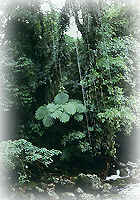
Orchids from the river Bananal margins
Interview with Maria da Penha Fagnani
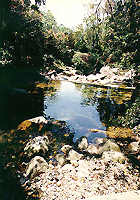
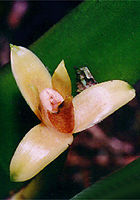 For the orchids, the dryness of the lower montane rain forest is always attenuated by the proximity of the river mainly for those which grow above the water . The temperature varies according to the altitude, decreasing 1oC for each 100m up (Veloso et al). At 230m, the during the year, it varies from 8o to 38oC.
For the orchids, the dryness of the lower montane rain forest is always attenuated by the proximity of the river mainly for those which grow above the water . The temperature varies according to the altitude, decreasing 1oC for each 100m up (Veloso et al). At 230m, the during the year, it varies from 8o to 38oC. 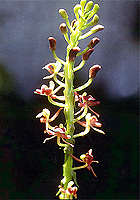 Cyclopogon longibracteatus (Barb. Rodr.) Schltr grows in a strump of a tree in decomposition.
Cyclopogon longibracteatus (Barb. Rodr.) Schltr grows in a strump of a tree in decomposition. 
I always thinked that the major preoccupation inside the OrquidaRio (Rio de Janeiro's orchids association) should be to elaborate a list of the orchids of the state of Rio de Janeiro. We started, almost by chance, with the orchids of the Massambaba beach because we liked to go there to swing in the lagoon and to do picnic, besides to see the orchids. When I started to study botanical systematic, I also became interested in identifying the species. Some years ago, a colleague also from OrquidaRio, Nilson Moneró, advised us that the region around the margins of Bananal river was extremely rich in orchids but I was so involved with Massambaba and always said that we should finish the research there before starting Guapimirim. When we finished the research in Massambaba, the opportunity to work in Guapimirim appeared because a colleague, also from OrquidaRio, Jorge, has a house close to the place where we would go to study. So, Jorge, Carlos Ivan, me and two biologist, João Marcelo and Maximo Bovini, have started the research. Jorge's house became our base for the operation, we went up and down and always had a shelter to take a bath, to change clothes and sometimes, to sleep.
What was the area research in Guapimirim?
Our research started since 210m, close to the road, in direction to the river source. In the list of the orchids, the code LM means forest situated up to 500m, the code M is concerned to the forest situated above the 500m.
The river source is just a thread of water, at almost 2.000m altitude where only the mountaineers very skilled at climbing could reach. 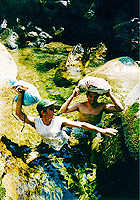 In the lower part of the river, at 600m, there was some path-ways, I walked among the stones and due to a friend's help, who lived in the area, I could reach some path-ways which token to the river. They were 5m from the margins of the river so we were inside this established limit from 0 to 30m. From 700 to about 1.400m, the research was done by the group formed by the younger and taller, Jorge Figueiredo, Maximo Bovini e João Marcelo. They are more than 1.80m, thin and slender and with a very good physical conditions.
In the lower part of the river, at 600m, there was some path-ways, I walked among the stones and due to a friend's help, who lived in the area, I could reach some path-ways which token to the river. They were 5m from the margins of the river so we were inside this established limit from 0 to 30m. From 700 to about 1.400m, the research was done by the group formed by the younger and taller, Jorge Figueiredo, Maximo Bovini e João Marcelo. They are more than 1.80m, thin and slender and with a very good physical conditions.
At those altitudes, the access is very hard and full of risk. I stayed down, they climbed by the water , taking risks and sometime falling down because the margins of the river don't offer the conditions to walk. They went up to the stones and collected what was close to them or what was hanging over the river. That was how they got Pabstia, Masdevallia, some Epidendrums and several others plants which are included on the list. Some of them were found in those elevated altitudes.
I believe that in the remotes areas from the river, perhaps there is a new specie but the access was not available. To get in the river, the group walked bare-foot and wearing just a swimming suit, how could they get into the wood without the appropriate clothes?
The conditions were hard, difficult. The further along you go up, the margins and the stones on the river became an escarpment like Finger of Gold mountain.. In reality, the part of alpinist, climbing mountain, I didn't do it.
How is the humidity level of this region?
In the upper part of the forest, in some areas, during the day, the humidity is lower because the evaporation is elevated but the further along you go up and more close to the river, the level rises.
See the Comparettia coccinea, it was in a area where during the day the dryness was extremely.
Since the road, from 210m to 400m, there is a relative dryness at noon although it is close to the river. So I found out why I didn't succeed in cultivating Warmingia euginii.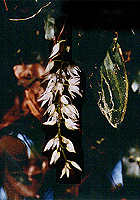 This specie became very interesting to me in this region because, Guido Pabst, in his 2 volumes of "Orchidaceae Brasilienses" doesn't point out as Warmingia eugenii as part of the fluminense (from the state of Rio de Janeiro) flora.
This specie became very interesting to me in this region because, Guido Pabst, in his 2 volumes of "Orchidaceae Brasilienses" doesn't point out as Warmingia eugenii as part of the fluminense (from the state of Rio de Janeiro) flora.
However, we found it above the river, with a certain height and certain distance and in an altitude of 300m and so, where the dryness is relative. It is an epiphytic orchid. At night, it receive a great humidity because the river is just under it but during the day, it has the total dryness it requires. That is why I lost 3 or 4. I insisted on taking them moist because who sold me them, said me they love humidity but he didn't give me the details.
What is the importance of the Bananal river to the eco-system of Rio de Janeiro?
The source and the margins of the Bananal river are very important to the whole eco-system of the Guanabara bay because it flows into Guapi river which is part of the unique remaining system of conserved mangroves in Guanabara bay. If there is the completely destruction of the flora on the source and its margins, the water will be polluted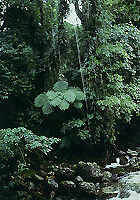 .
.
This will reflect in the mangroves which would loose their characteristics and would be destroyed. It very important that the vegetation in the margins of the river stay untouchable. On the right margin looking to the source of the river, between 210 m ant 400m, the region were inhabited by Indians. During the last century, a coffee farmer was settled there. This old farmer was transformed in condominium. Many summer houses were constructed. The people who lives in those houses has a good point of view about the ecology and have maintained the big trees which are along the river inside a area of 10m. After this, they destroyed to construct their houses but the big trees were conserved. This people had a remarkable ecology consciousness.
Nowadays I am very happy that one of the most conserved Laelias crispa is situated inside the ground of one of those houses, at 400m, where no one touches, in an enormous tree. From 400 to 600m, there is nothing, aAt 700m, there is the last house. I heard that at 210m until the sea level, the margins are depredated but I didn't go there so I can't affirm this. In a shoot taken by Carlos Ivan, we can see people washing clothes, taking bath because it is the lower part. The access is easier.
So, what is the importance of this flora to this hydrological basin, to the quality of the water in the hydrological basin? The roots keep and filter the sediments so the water arrives clean at the river. By the existence of this flora, of those big trees and big roots, the quality of the water is maintained. They make the water potable. The flora is necessary, essential to maintain the quality of the water. Protecting and maintaining the fountain-head potable, you also protect the fauna.
How do you classify the wood at he margins of Bananal river?
It is part of the Mata Atlântica (Atlantic rainforest). At the LM zones, the wood is dense and umbrageous, the humidity level is low during the day but the further along you go up, it becomes less dense. At 1.200m, the trees are not big and from 1400m to the up, they are very small.
You talked about another research done in Massambaba beach. Is it already published?
It published in the OrquidaRio bulletin and the material, photos and text, was sent to be published on the Proceedings of the 15th World Orchids Conference. It has been translated and will be published in two volumes, in English and in Portuguese. However this one on Guapimirim has just been published in the OrquidaRio bulletin and presented as a panel during the 15Th WOC.
Have you found a new specie?
I am very exigent until now, every think I found it was knew when I started my investigation, I found out that it wasn't. Someone had already described it. In the list, you will find Gomesa and Pleurothallis pointed with a "spp" (species), it means, I don't know what they are, they can be a new species but I have to investigate very hard before saying something.
Do you think there is some new species, not described yet?
Guapimirim is situated in the Serra dos Órgãos, where there is the National Park , this region is often visited, although the specific area were we worked is not so visited, I think there is a little probability. But in remotes places, it is probably. In Massambaba beach, there is a plant which can be new. I will return to the place where it exists or existed. It is very small, smaller than Pleurothallis. This is presumed to bloom in May. Fortunately someone has collected one in case if it had disappeared. This plant is not in none of the lists of the orchids of Massambaba beach. My list and the others are not similar. The great difference is due to the fact that my research is for actualizing, what exists nowadays and the others were token from the herbariums of the state of Rio de Janeiro. Something that I didn't find there, perhaps doesn't exist any more, disappeared or I didn't find it flowering like some terrestrials, Habenaria. In the margins of Bananal river, there is Epidendrum hololeucum Barb. Rodr only in this type of area. It is a small zone, a restrict habitat, specific, endemic to Rio de Janeiro, to this local. If this area finishes, Epidendrum hololeucum also finishes.
Penha, who participates on this research group, besides you?
Jorge Reis de Figueiredo, an orchid lover, João Marcelo and Massimo G.Bovini, botanists, Carlos Ivan da Silva Siqueira, photographer.
| Since this issue, we will be presenting, in this topic, orchids cultivated by professional and/or amateurs growers. The information given with the photo will be the plant's identification and the grower's name. If you want to show your orchid, click on it to know how to do. THIS IS NOT A CONTEST.The flowers will not be judged. This is only a place to expose beautiful orchids. |
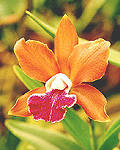 |
| Species | blooming | Altitude * | Compost |
| Bifrenaria harrisoniae (Hook) Rchb .f | October | SM | rupicolous ** |
| Bifrenaria tetragona (Lindl.) Schltr. | January | SM/M | rupicolous /epiphytic |
| Campylocentrum lansbergii (Rchb.f) Schltr. | March | SM | epiphytic ** |
| Campylocentrum Ulaei Cogn. | March | SM | epiphytic ** |
| Campylocentrum Sellowi (Rchb.f.) Rolfe | August | SM | epiphytic ** |
| Comparettia coccinea Lindl. | March | SM | epiphytic |
| Cyclopogon argyrifolius Barb. Rodr. | October | SM | terrestrial |
| Cyclopogon congestus (Vell.) Hoehne | July | SM | terrestrial |
| Cyclopogon elatus (SW) Schltr. | July | M | epiphytic /terrestrial |
| Cyclopogon longibracteatus (Barb. Rodr.) Schltr. | August | M | terrestrial |
| Dichea graminoides Lindl. | March | SM | epiphytic |
| Dichea pendula (Aubl.) Cogn. | November | SM/M | epiphytic |
| Elleanthus brasiliensis Rchb.f | February | SM | epiphytic ** |
| Epidendrum armeniacum Lindl. | November | M | epiphytic ** |
| Epidendrum difforme Jacq. | February | M | epiphytic |
| Epidendrum Barb. Rodr. | July | M | epiphytic |
| Epidendrum imbricatum Lindl. | September | SM | epiphytic |
| Epidendrum klueppelianum Pabst | July | M | epiphytic |
| Epidendrum latilabre Lindl. | June | M | epiphytic |
| Epidendrum ochrochlorum Barb. Rodr. | June | M | epiphytic ** |
| Epidendrum ramosum Jacq. | January | M | epiphytic ** |
| Epidendrum Schomburgkii Lindl. | June | SM | epiphytic ** |
| Erythrodes arietina (Rchb. F & Warm.) Ames | October | M | terrestrial |
| Epidendrum schlecheriana (Hoehne) Pabst | August | M | rupicolous |
| Eurystyles cotyledon Wawra | April | M | epiphytic |
| Epidendrum lorenzii (Cogn.) Schltr. | August | M | epiphytic |
| Galeandra Beryrichii Rchb. f | January | SM | terrestrial |
| Gomesa Barkeri Regel | May | M | epiphytic |
| Gomesa crispa (Lindl.) KI. & Rchb. f | August | M | epiphytic |
| Gomesa Fischeri Regel | January | M | epiphytic |
| Gomesa foliosa Klostzch & Rchb. f | July | M | epiphytic |
| Gomesa laxiflora (Lindl.) KI. & Rchb. f | August | M | epiphytic |
| Gomesa planifolia (Lindl.) KI. & Rchb. f | June | M | epiphytic |
| Gomesa recurva R. Br. | August | M | epiphytic |
| Gomesa spp | |||
| Gongora bufonia Lindl. | November | SM/M | epiphytic |
| Hapalorchis lieatus (lindl) Schltr. | July | M | terrestrial |
| Isochilus linearis (Jacq. ) R. Br. | October | SM | epiphytic |
| Laelia crispa (Lindl.) Rchb. f | February | SM | epiphytic |
| Lankesterella ceracifolia (Barb. Rodr.) O Ames | July | SM | epiphytic |
| Liparis nervosa (Thunb.) Lindl. | March | SM | rupicolous ** |
| Masdevallia infracta Lindl. | November | M | epiphytic |
| Maxillaria acicularis Herb | September | SM | epiphytic |
| Maxillaria crassifolia Rchb. f | July/October | SM | epiphytic ** |
| Maxillaria leucaimata Barb. Rodr. | February | M | epiphytic ** |
| Maxillaria rufescens Lindl. | November | SM | epiphytic |
| Miltonia clowesii Lindl. | February | SM | epiphytic ** |
| Octomeria linearifolia Barb. Rodr. | November | M | epiphytic / rupicolous |
| Oncidium pubes Lindl. | July | SM | epiphytic |
| Ornithidium chloroleucum Barb. Rodr. | March | SM/M | epiphytic |
| Pabstia viridis (Lindl.) Garay | December | M | epiphytic |
| Pleurothallis arcuata Lindl | Juin | M | epiphytic** |
| Pleurothallis caespitosa Barb. Rodr. | May | M | epiphytic |
| Pleurothallis curtibradei Pabst | October | M | epiphytic** |
| Pleurothallis glumacea Lindl. | November | M | epiphytic** |
| Pleurothallis hypnicola Lindl. | July | SM/M | epiphytic** |
| Pleurothallis pelioxanta Barb. Rodr. | February to July | M | epiphytic |
| Pleurothallis spp. | |||
| Polystachya Estrellensis Rchb. f | March | S/M | epiphytic |
| Prescottia plantaginea Lindl | July | SM | terrestrial |
| Promenaea stapelioides Lindl. | December | M | rupicolous/epiphytic |
| Sarcoglottis fasciculata (Vell.) Schltr. | September | SM | terrestrial |
| Sarcoglottis grandiflora (Hk.) KI | May | SM | terrestrial |
| Tetragamestus modestus Rchb. f. | May | SM | epiphytic |
| Trizeuxis falcata Lindl. | November | SM | ep |
| Xylobium variegatum (Ruiz e Pavon)) Masnf. | July | SM | epiphytic |
| Warmingia eugenii Rchb. f. | October | SM | epiphytic |
| Warrea tricolor Lindls | February | SM/M | terrestrial |
| * | SM = up to 500 m. |
| M = above 500 m. | |
| ** | orchids growing above the water |